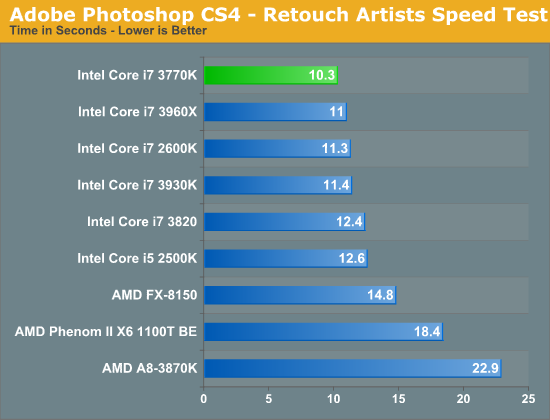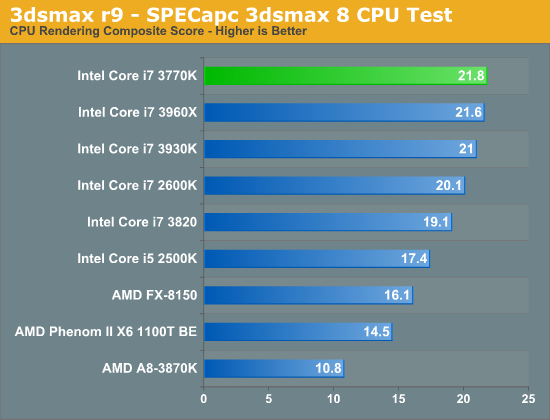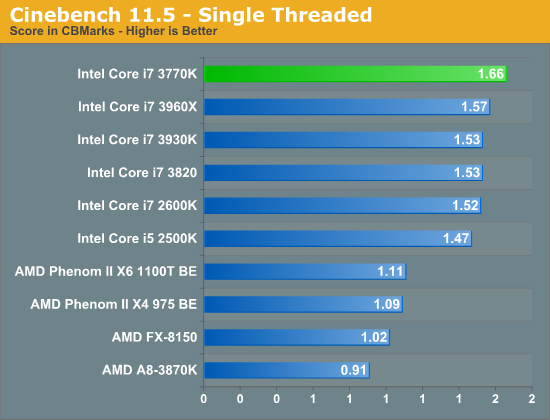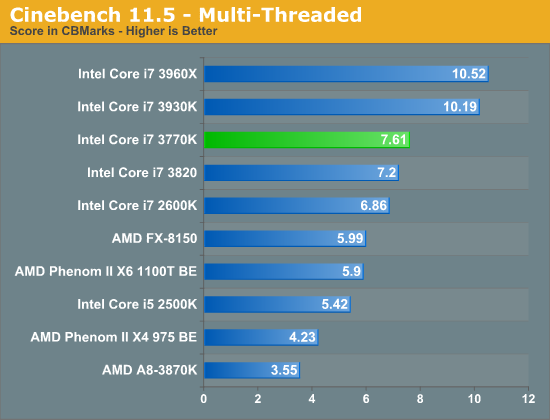The Ivy Bridge Preview: Core i7 3770K Tested
by Anand Lal Shimpi on March 6, 2012 8:16 PM EST- Posted in
- CPUs
- Intel
- Core i7
- Ivy Bridge
Content Creation Performance
Adobe Photoshop CS4
To measure performance under Photoshop CS4 we turn to the Retouch Artists’ Speed Test. The test does basic photo editing; there are a couple of color space conversions, many layer creations, color curve adjustment, image and canvas size adjustment, unsharp mask, and finally a gaussian blur performed on the entire image.
The whole process is timed and thanks to the use of Intel's X25-M SSD as our test bed hard drive, performance is far more predictable than back when we used to test on mechanical disks.
Time is reported in seconds and the lower numbers mean better performance. The test is multithreaded and can hit all four cores in a quad-core machine.

Our Photoshop test is well threaded but it doesn't peg all cores constantly. Instead you get burstier behavior. With the core count advantage out of the way, SNB-E steps aside and allows the 3770K to step up as the fastest CPU we've tested here. The performance advantage over the 2600K is around 9%.
3dsmax 9
Today's desktop processors are more than fast enough to do professional level 3D rendering at home. To look at performance under 3dsmax we ran the SPECapc 3dsmax 8 benchmark (only the CPU rendering tests) under 3dsmax 9 SP1. The results reported are the rendering composite scores.

In another FP heavy workload we see a pretty reasonable gain for Ivy Bridge: 8.5% over a 2600K. This isn't enough to make you want to abandon your Sandy Bridge, but it's a good step forward for a tick.
Cinebench 11.5
Created by the Cinema 4D folks we have Cinebench, a popular 3D rendering benchmark that gives us both single and multi-threaded 3D rendering results.

The single threaded Cinebench test shows a 9% performance advantage for the 3770K over the 2600K. The gap increases slightly to 11% as we look at the multithreaded results:

If you're running a workload that can really stress multiple cores, the 6-core Sandy Bridge E parts will remain unstoppable but in the quad-core world, Ivy Bridge leads the pack.










195 Comments
View All Comments
krumme - Wednesday, March 7, 2012 - link
Well the dilemma for Anand is apparent. If he stops writing those previews that is nice to Intel, someone else will get the oportunity and all the info. He can write two bad previews and the info and early chips just stops comming. Intel and Anand have a business to run, and there is a reason Intel gives Anand the chips (indirectly).He have a "deal" with Intel, the same way we have a deal with Anand when we read the review. We get the info - bended/biased - and then we can think ourselves. I think its a fair deal :) - we get a lot of good info from this preview. The uninformed gets raped, but its alway like that. Someone have to pay for the show.
chemist1 - Wednesday, March 7, 2012 - link
The Macbook Pro, for instance, has a discrete GPU, yet can switch to the chip-based GPU to save power when on battery. So having a better chip-based GPU makes sense in this context.Sabresiberian - Wednesday, March 7, 2012 - link
I'd like to see the discreet graphics card industry make the kind of progress, relatively speaking, Intel has made in the last 2 years.Ivy Bridge is a ways from competing with a high-end discreet solution, but if the relative rates in progress don't change, Intel will catch up soon.
sixtyfivedays - Wednesday, March 7, 2012 - link
I use the iGPU on my build for my second monitor and it is quite nice.I can watch HD videos on it and it doesn't take away from my dedicated GPU at all.
mlkmade - Thursday, March 8, 2012 - link
Is that even possible? Special hack or software?When you install a discrete graphics card, the integrated gpu gets disabled.
Would love to know how you accomplished this..Is it a desktop or laptop?
mathew7 - Thursday, March 8, 2012 - link
"When you install a discrete graphics card, the integrated gpu gets disabled."It was exclusive in northbridge-IGP units (Core2Duo/Quad and older). With Core-i, it's by default disabled but can be enabled through BIOS (of course if you don't have a P5x/6x chipset).
AnnonymousCoward - Wednesday, March 7, 2012 - link
1. How much faster is Ivy Bridge at single thread versus my Conroe@3GHz?2. How much faster is my GTX560Ti than HD4000?
dr/owned - Thursday, March 8, 2012 - link
1) Your 65 nm cpu would get the shit blow out of it by IB at the same clock speed in single threaded applications. Assuming 15% improvements in each of the tick-tocks since Conroe, a 1.8 Ghz IB would probably be about the same as a 3 Ghz Conroe.2) Discrete graphics vs. integrated graphics. Intel isn't trying to compete here so it's a stupid comparison.
AnnonymousCoward - Friday, March 9, 2012 - link
1. Your "get the shit blown out" is worthless. All I'm looking for is a number, and your effective answer is +67%.2. It's not a stupid comparison, because:
a) I'm interested.
b) HD4000 is designed for games.
c) They benchmarked with modern games.
d) Games are designed around people's performance.
AnnonymousCoward - Friday, March 9, 2012 - link
1. Another website shows the i7 3770K scored 2643 on the Fritz Chess Benchmark with 1 processor. My machine does 2093. That's only 26% different.2. I very roughly estimate the GTX560Ti might be 5-6x faster than the HD4000.
It'd be useful to see a real comparison of these though.